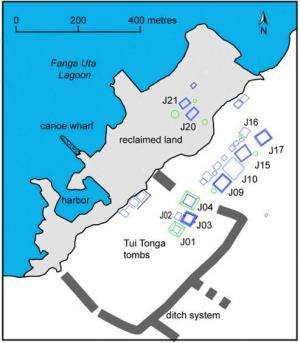July 8, 2014 report
Research Reveals Tonga's Role as Pacific Trade Hub

(Phys.org) —A geochemical analysis of prehistoric stone artifacts has revealed that Tonga was once the hub of a Pacific trading empire as large as 500,000 square kilometers. In a study published in the Proceedings of the National Academy of Sciences, Geoffrey Clarke of Australian National University and his team analyzed Tongan stone artifacts and found that two-thirds of them came from outside Tonga, one from as far as 2,500 kilometers away. The researchers believe Tonga served as a trade hub where people from across Polynesia traveled to exchange goods and political ideas.
In the first half of the second millennium A.D. chieftainships in the archipelago of Tonga combined to form one central political system, and Tonga became the only politically unified archipelago in Polynesia. The centralized government developed political and economic relations with other islands and archipelagos, becoming the seat of a large maritime empire.
To understand just how far this empire extended, Clarke's team studied Tongan stone artifacts to find out how many were imported and where the imports originated. They examined more than 500 artifacts found in Tongan political centers, most of them near royal tombs. Because different types of rocks make up the different Central Pacific islands, the researchers were able to determine the artifacts' places of origin by analyzing their composition.
Clarke's team found that about two-thirds of stone tools they studied came from Fiji, Samoa and Tahiti, 2,500 miles away from Tonga. Based on their findings, the the team estimates that that the Tongan trading empire could have been 500,000 square kilometers in size. Traditional histories and linguistic evidence suggest that Tonga's zone of influence was even larger.
The researchers think imported artifacts served as capital for supporting political centralization, which would have depended on long distance canoe voyages. Exotic goods would have played a role in political marriages designed to increase the spheres of influence of Tongan chiefs. Foreigners would have sent valuable items as tribute during major ceremonies attended by people from all over Tonga.
When the team studied stone tools found in Samoa, they found that very few of these were imports. The Samoans focused on producing high quality adzes for their own use and for export. This shows that the two societies evolved along separate paths, one focusing on craft specialization and the other on political centralization and expansion.
The researchers think that by centralizing authority, Tongan rulers enabled the formation of interaction centers throughout the archipelago. Within these interaction centers, people from throughout Polynesia shared goods and ideas about political organization and then disseminated them across the prehistoric Pacific.
More information: Stone tools from the ancient Tongan state reveal prehistoric interaction centers in the Central Pacific, Geoffrey R. Clark, PNAS, DOI: 10.1073/pnas.1406165111
Abstract
Tonga was unique in the prehistoric Pacific for developing a maritime state that integrated the archipelago under a centralized authority and for undertaking long-distance economic and political exchanges in the second millennium A.D. To establish the extent of Tonga's maritime polity, we geochemically analyzed stone tools excavated from the central places of the ruling paramounts, particularly lithic artifacts associated with stone-faced chiefly tombs. The lithic networks of the Tongan state focused on Samoa and Fiji, with one adze sourced to the Society Islands 2,500 km from Tongatapu. To test the hypothesis that nonlocal lithics were especially valued by Tongan elites and were an important source of political capital, we analyzed prestate lithics from Tongatapu and stone artifacts from Samoa. In the Tongan state, 66% of worked stone tools were long-distance imports, indicating that interarchipelago connections intensified with the development of the Tongan polity after A.D. 1200. In contrast, stone tools found in Samoa were from local sources, including tools associated with a monumental structure contemporary with the Tongan state. Network analysis of lithics entering the Tongan state and of the distribution of Samoan adzes in the Pacific identified a centralized polity and the products of specialized lithic workshops, respectively. These results indicate that a significant consequence of social complexity was the establishment of new types of specialized sites in distant geographic areas. Specialized sites were loci of long-distance interaction and formed important centers for the transmission of information, people, and materials in prehistoric Oceania.
Journal information: Proceedings of the National Academy of Sciences
© 2014 Phys.org


















